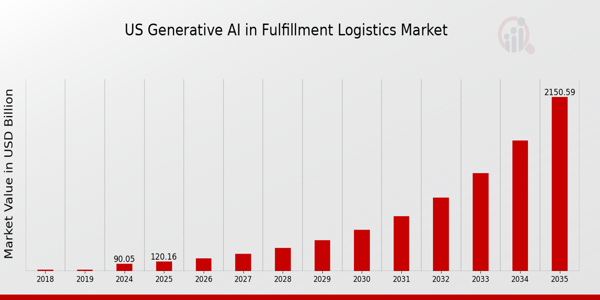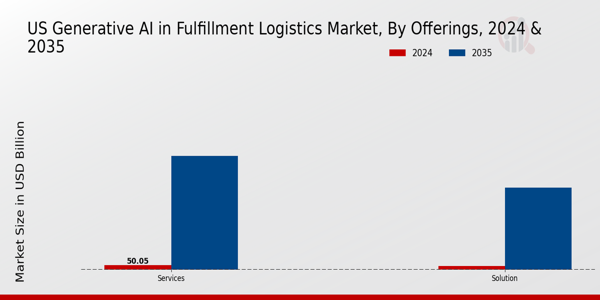US Generative AI in Fulfillment Logistics Market Overview
As per MRFR analysis, the US Generative AI in Fulfillment Logistics Market Size was estimated at 62.7 (USD Billion) in 2023. The US Generative AI in Fulfillment Logistics Market is expected to grow from 90.05 (USD Billion) in 2024 to 2,150.54 (USD Billion) by 2035. The US Generative AI in Fulfillment Logistics Market CAGR (growth rate) is expected to be around 33.438% during the forecast period (2025 - 2035).
Key US Generative AI in Fulfillment Logistics Market Trends Highlighted
The requirement for supply chain operations to be more efficient and less expensive is driving the market for generative AI in fulfillment logistics in the United States. Businesses are looking for cutting-edge solutions to automate and streamline logistics procedures as online purchasing continues to grow.
Better demand forecasting, inventory control, and route optimization are made possible by the use of generative AI into fulfillment logistics, which improves customer satisfaction and expedites delivery times. Furthermore, companies are using AI to improve data analysis and decision-making, which aids in navigating the US market's intricate supply chain issues.
Businesses who can successfully use generative AI tools to enhance their logistical skills are seeing opportunities. With the help of this technology, supply chains can become more responsive to shifts in consumer preferences and market demands. Greater competitiveness and more strategic planning may result from the capacity to evaluate enormous volumes of data in real-time.
There is a chance for cooperation that can encourage innovation and result in more specialized solutions that address certain industry demands as US businesses look into joint ventures with technology suppliers. Sustainability has become more and more important in fulfillment logistics in recent years, and generative AI can be quite helpful in this regard.
Through route optimization and waste reduction, businesses can reduce their carbon footprint without sacrificing productivity. In addition to consumer demand, legislative demands in the US to lessen environmental effect are also driving the need for sustainability. Sustainability and technology are coming together to create a potent trend whereby eco-friendly methods can improve fulfillment processes.

Source: Primary Research, Secondary Research, MRFR Database and Analyst Review
US Generative AI in Fulfillment Logistics Market Drivers
Surging E-commerce Growth
The US e-commerce market has shown significant growth, reaching approximately 800 billion USD in 2021 and projected to surpass 1 trillion USD by 2023 according to the U.S. Department of Commerce.This rapid expansion is driving the need for more efficient fulfillment logistics, where Generative Artificial Intelligence can streamline operations such as inventory management, demand forecasting, and last-mile delivery.
Companies like Amazon are heavily investing in advanced logistics technologies, including Generative AI, to improve operational efficiency and enhance customer experience. The rise in online shopping continues to push organizations to seek innovative solutions, making the US Generative AI in Fulfillment Logistics Market increasingly essential for meeting consumer demands.
Integration of Advanced Automation Technologies
The increasing adoption of automation technologies in fulfillment centers across the US is impacting logistics significantly. According to the United States Bureau of Labor Statistics, employment in the warehousing and storage sector is anticipated to grow by 9% from 2020 to 2030.
This highlights the industry's shift towards automation which, when integrated with Generative AI, can optimize tasks such as sorting, packing, and routing. Companies like FedEx and UPS have begun implementing AI-driven solutions to enhance operational efficiency and reduce labour costs.This trend towards advanced automation will continue to fuel growth in the US Generative AI in Fulfillment Logistics Market.
Demand for Enhanced Supply Chain Visibility
As companies strive for transparency within their supply chains, the demand for solutions that provide real-time insights is increasing. According to the Council of Supply Chain Management Professionals, over 79% of companies reported they need more visibility in their supply chain operations.
Generative AI can analyze vast amounts of data, providing actionable insights into supply chain efficiency, risk management, and performance metrics. Organizations like Walmart are utilizing AI technologies to gain better visibility and improve responsiveness to market fluctuations.This level of transparency not only builds trust but is a crucial factor driving the growth of the US Generative AI in Fulfillment Logistics Market.
US Generative AI in Fulfillment Logistics Market Segment Insights
Generative AI in Fulfillment Logistics Market Offerings Insights
The US Generative AI in Fulfillment Logistics Market offers a diverse range of offerings that are crucial for streamlining logistics operations and enhancing efficiency. This market can be broadly classified into Solutions and Services, each contributing significantly to the overall dynamics of the logistics sector.Solutions, encompassing advanced AI-driven technologies, play a vital role in automating and optimizing logistics processes, enabling companies to reduce operational costs while improving delivery speed and accuracy.
These technologies leverage vast datasets to predict demand, optimize routes, and manage inventory more effectively, ultimately resulting in a more responsive supply chain that meets consumer expectations.On the other hand, Services in this market focus on providing support and expertise to implement and maintain these solutions effectively. They are essential for organizations to harness the full potential of Generative AI, as they often contribute to the integration of various technologies with existing logistics frameworks.
Moreover, as the industry evolves, companies that provide consulting and support services are poised to grow, aiding organizations in navigating the complexities associated with the adoption of new AI technologies.The demand for both Solutions and Services is driven by several trends, including the increasing need for real-time data analytics, the rise of e-commerce, and consumer expectations for fast and reliable deliveries.
As companies seek to enhance their competitive edge, investing in Generative AI becomes imperative for maintaining agility and efficiency. However, challenges such as the integration of legacy systems and the need for skilled personnel persist, making the Services aspect of this market incredibly significant.Overall, the US Generative AI in Fulfillment Logistics Market is characterized by a robust growth trajectory, as stakeholders continue to recognize the transformative potential of AI technologies in redefining logistics paradigms.

Source: Primary Research, Secondary Research, MRFR Database and Analyst Review
Generative AI in Fulfillment Logistics Market Type Insights
The US Generative AI in Fulfillment Logistics Market is increasingly categorized by different types of algorithms that enhance operational efficiency and effectiveness. Variational Autoencoders (VAE) are gaining traction in this market for their ability to compress data while retaining essential features, making them beneficial in predictive analytics.
Generative Adversarial Networks (GANs) also play a crucial role, specifically in synthesizing realistic images and data that are useful for inventory management and supply chain optimization, helping businesses make data-driven decisions.Recurrent Neural Networks (RNNs) are significant in time series forecasting, crucial for tracking and managing logistics timelines, while Long Short-Term Memory (LSTM) networks extend this capability by remembering information over long periods, enhancing predictive accuracy in logistics routing.
The integration of these types in the industry supports various applications like intelligent routing, real-time inventory tracking, and demand forecasting, thereby greatly improving operational efficiencies.Collectively, the increasing reliance on these advanced techniques illustrates the ongoing evolution and segmentation in the US market, contributing to its dynamic growth landscape and creating opportunities for companies to innovate in the fulfillment logistics arena.
Generative AI in Fulfillment Logistics Market Application Insights
The US Generative AI in Fulfillment Logistics Market, particularly within the Application segment, showcases diverse avenues for automation and efficiency enhancements. Warehouse Operations has become increasingly vital, leveraging Generative AI to streamline tasks and increase throughput, leading to improved productivity.
Optimization and Management play a critical role in ensuring resources are utilized efficiently, reducing costs while maximizing output. Supply Chain Operations benefit significantly through predictive analytics, allowing businesses to forecast demand and tailor their supply chains accordingly.
Predictive Maintenance helps in minimizing equipment failures and downtime, inherently supporting operational continuity. Logistics Network Design integrates AI to optimize routes and reduce fuel consumption, aligning with sustainability goals. Inventory Management benefits from real-time data analytics, enabling better stock control and reduced waste.
Additionally, Fraud Detection employs AI to identify and mitigate risks, ensuring security and integrity within logistics processes. Autonomous Robotics is set to transform the landscape of fulfillment logistics, facilitating faster order processing and reducing human errors.Lastly, Data Analytics and Reporting empower organizations with actionable insights, driving data-driven decision-making. Overall, the Application segment within the US Generative AI in Fulfillment Logistics Market is positioned for transformative growth, addressing both operational challenges and opportunities for enhancement.
Generative AI in Fulfillment Logistics Market Industrial vertical Insights
The US Generative AI in Fulfillment Logistics Market focused on the Industrial vertical is shaping up to be a dynamic and multifaceted area of growth. The Automotive sector plays a crucial role, utilizing Generative AI to optimize supply chains and enhance vehicle delivery processes, driving efficiency in logistics operations.In the Pharmaceutical and Healthcare domain, AI technologies are essential for managing the complexities of drug distribution, ensuring compliance, and reducing lead times. The Semiconductors and Electronics industry benefits significantly from AI's capabilities in demand forecasting and inventory management, leading to improved responsiveness to market changes.
Retail and E-Commerce reflect a significant impact through personalized customer experiences and automated order fulfillment systems, which are increasingly dependent on Generative AI to manage vast product catalogs effectively.The Food sector faces unique challenges, and the application of Generative AI aids in streamlining processes such as supply chain management and compliance with food safety regulations.
Overall, the importance of these segments lies in their potential for operational optimization and market adaptability, contributing significantly to the overarching growth and innovation within the US Generative AI in Fulfillment Logistics Market landscape.
US Generative AI in Fulfillment Logistics Market Key Players and Competitive Insights
The US Generative AI in Fulfillment Logistics Market is characterized by an evolving landscape where tech-driven solutions are increasingly integrated into logistics operations.As the demand for more efficient and effective fulfillment strategies continues to grow, businesses are turning to generative AI technologies to enhance decision-making processes, improve operational efficiencies, and optimize supply chain management.
This market is becoming highly competitive, with companies leveraging advanced algorithms and machine learning capabilities to streamline logistics workflows, reduce costs, and respond proactively to market demands. Analyzing the competitive insights in this sector reveals a mix of established players and emerging startups, all keen on capturing market share through innovative generative AI applications.Oracle has established a formidable position within the US Generative AI in Fulfillment Logistics Market, showcasing its strengths through comprehensive cloud-based logistics solutions that integrate generative AI functionalities.
The company offers a robust portfolio of applications that encompass warehouse management, order fulfillment, and inventory optimization, strengthened by advanced data analytics capabilities. Oracle’s market presence is bolstered by its commitment to innovation and continuous improvement, creating systems that facilitate real-time insights and agile response mechanisms within supply chains.Additionally, its extensive customer base and partnerships across various industries enhance its competitive edge, allowing Oracle to maintain a leading role in driving AI adoption within fulfillment logistics.
Blue Yonder has emerged as a key player in the US Generative AI in Fulfillment Logistics Market, providing a suite of software solutions that optimize supply chain and fulfillment operations through AI-driven insights.The company specializes in products that focus on demand planning, transportation management, and inventory optimization, relying heavily on predictive analytics and machine learning to deliver enhanced operational efficiencies.
Blue Yonder's market presence is underscored by strategic mergers and acquisitions that have broadened its technological capabilities and market reach, further solidifying its competitive stance.The cultivation of strong customer relationships and an emphasis on tailored solutions have positioned Blue Yonder as a formidable force in the industry, enabling organizations to achieve greater agility and responsiveness in fulfillment logistics.
Key Companies in the US Generative AI in Fulfillment Logistics Market Include:
- Oracle
- Blue Yonder
- Siemens
- Zebra Technologies
- Google
- Nvidia
- Llamasoft
- SAP
- ai
- Salesforce
- UiPath
- IBM
- Amazon
- Microsoft
- Cognex
US Generative AI in Fulfillment Logistics Market Developments
Oracle unveiled its Generative AI Agents service in August 2025. This fully managed platform combines AI technologies with massive language models to produce intelligent virtual agents. These agents provide context-aware, tailored interactions with the goal of improving client experiences.Oracle's dedication to incorporating cutting-edge AI capabilities into its supply chain and logistics solutions is demonstrated by this breakthrough.
Similarly, Blue Yonder introduced its Generative AI capacity in July 2025 with the goal of streamlining supply chain orchestration and management. This technology helps teams better traverse complicated supply chain difficulties by converting raw data into usable insights through the use of predictive, generative, and agentic AI technologies.
Zebra Technologies' Symmetry Fulfillment solution, an AI-powered platform that integrates robot fleet management, analytics, and warehouse execution tools, was expanded in June 2025. Zebra's continuous innovation in AI-driven logistics solutions is demonstrated by this expansion, which attempts to boost fulfillment operations' productivity and efficiency.These developments demonstrate how actively these businesses are incorporating generative AI into fulfillment logistics, improving decision-making and operational effectiveness.
Generative AI in Fulfillment Logistics Market Segmentation Insights
Generative AI in Fulfillment Logistics Market Offerings Outlook
Generative AI in Fulfillment Logistics Market Type Outlook
- VAE
- GANs
- RNNs
-
LSTM Networks
Generative AI in Fulfillment Logistics Market Application Outlook
- Warehouse Operations
- Optimization and Management
- Supply Chain Operations
- Predictive Maintenance
- Logistics Network Design
- Inventory Management
- Fraud Detection
- Autonomous Robotics
- Data Analytics & Reporting
Generative AI in Fulfillment Logistics Market Industrial vertical Outlook
- Automotive
- Pharmaceutical & Healthcare
- Semiconductors & Electronics
- Retail & E-Commerce
- Food
|
Report Attribute/Metric
|
Details
|
|
Market Size 2023
|
62.7(USD Billion)
|
|
Market Size 2024
|
90.05(USD Billion)
|
|
Market Size 2035
|
2150.54(USD Billion)
|
|
Compound Annual Growth Rate (CAGR)
|
33.438% (2025 - 2035)
|
|
Report Coverage
|
Revenue Forecast, Competitive Landscape, Growth Factors, and Trends
|
|
Base Year
|
2024
|
|
Market Forecast Period
|
2025 - 2035
|
|
Historical Data
|
2019 - 2024
|
|
Market Forecast Units
|
USD Billion
|
|
Key Companies Profiled
|
Oracle, Blue Yonder, Siemens, Zebra Technologies, Google, Nvidia, Llamasoft, SAP, C3.ai, Salesforce, UiPath, IBM, Amazon, Microsoft, Cognex
|
|
Segments Covered
|
Offerings, Type, Application, Industrial vertical
|
|
Key Market Opportunities
|
Real-time inventory optimization, Automated demand forecasting, Enhanced route planning, Predictive maintenance solutions, Streamlined customer communication
|
|
Key Market Dynamics
|
increased operational efficiency, improved demand forecasting, enhanced supply chain visibility, reduced labor costs, automated decision-making
|
|
Countries Covered
|
US
|
Frequently Asked Questions (FAQ):
The market size was valued at 90.05 billion USD in 2024.
By 2035, the market is projected to reach 2150.54 billion USD.
The expected CAGR for the market during this period is 33.438%.
The 'Services' segment is expected to grow from 50.05 billion USD in 2024 to 1250.54 billion USD by 2035.
The 'Solution' segment is expected to reach a valuation of 900.0 billion USD by 2035.
Major players include Oracle, Blue Yonder, Siemens, and IBM, among others.
Key applications include inventory management, order fulfillment, and supply chain optimization.
Challenges include integrating AI technologies with existing systems and managing data privacy.
Growth opportunities lie in advancements in AI technologies and increasing demand for automation in logistics.
Current global events have heightened the focus on supply chain resilience and automation in logistics.
















